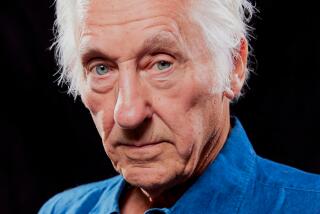Leonard Knight dies at 82; visionary artist of Salvation Mountain
His aging truck was wheezing and the hot-air balloon in the trailer was ragged and non-functional.
So Leonard Knight, self-described “little hobo bird,” pulled into a barren patch of desert in the Imperial Valley and decided that he had found the right spot to bring his message to the world: “God is Love.”
He planned to spend a week or two. But then he was gripped by the spirit.
For the next three decades the lean and sturdy New Englander joyously painted a tall mound of adobe he called Salvation Mountain. He painted pastoral scenes and biblical quotations, all supporting a universal theme.
“Love Jesus and keep it simple,” he once said, explaining his philosophy of life.
Knight died Monday at the Eldorado Care Center in El Cajon where he had lived for more than two years after failing health forced him reluctantly to leave his mountain. He was 82.
“He just decided it was his time: that he had done everything he could in this world,” said Dan Westfall, who formed a nonprofit organization to preserve Knight’s labor of love located east of the Salton Sea near the community known as Slab City.
Until his health declined, Knight had lived in the back of his truck, sharing his space with a variety of cats without names, undeterred by the brutal desert heat or howling winds. He had no electricity, running water or telephone.
The mountain is a sloping, terraced hill about three stories tall and 100 feet long and crowned with a cross. The property is owned by the state, but efforts to oust Knight ended long ago.
Much of the paint was donated by “snowbirds” arriving in the area for the winter warmth. “God has a way of supplying my needs,” Knight said.
There were setbacks: A lightning strike destroyed the original cross. A rainstorm washed the paint to the desert floor. Knight merely redoubled his efforts, often working at night with a flashlight.
Knight was born Nov. 1, 1931, in Shelburne Falls, Vt. He quit high school and enlisted in the Army and, after service in Korea, moved to Nebraska. where he worked as a welder, handyman, guitar teacher, painter and body-and-fender man.
He was visiting his sister in San Diego in the early 1980s when he decided to find a location to express his pent-up religious devotion. He arrived in Slab City with his truck, an old tractor and a hot-air balloon that he had once hoped to use for a cross-country trip.
“We’ve just got to start loving God more, and these things like wars wouldn’t happen,” he said. “God’s love is the strongest force. It can squash hate.”
Although he never sought attention, numerous news stories brought him a kind of international celebrity that he cherished.
To his amazement, he became a favorite of folk art aficionados. His brightly painted truck was dismantled and taken to a museum in Baltimore for display. His picture and that of his truck and mountain graced the cover of the book “Self-Made Worlds: Visionary Folk Art Environments.” Documentary films were made about Knight and his mountain.
The Folk Art Society of America declared that Salvation Mountain must be saved. In the Congressional Record, U.S. Sen. Barbara Boxer (D-Calif.) called the mountain “a national treasure … a sculpture for the ages — profoundly strange and beautifully accessible.”
Knight played himself in the 2007 movie “Into the Wild,” directed by Sean Penn, with a scene set at Salvation Mountain. The movie brought more visitors — movie fans, religious pilgrims and the curious — to the mountain.
He was honored at the Tomato Festival in nearby Niland and the Cattle Call parade in Brawley.
Despite his religious beliefs, he never sought to proselytize. He greeted all visitors cheerfully. He wrote songs and strummed his guitar.
“If somebody gave me $100,000 a week to move somewhere and live in a mansion and be a big shot, I’d refuse it,” he told The Times in 1993. “I want to be right here. It’s amazing, isn’t it?”
Knight is survived by a brother, Frank, and sisters Irene and Norma. Plans are for cremation and then inurnment at Fort Rosecrans National Cemetery in San Diego.
Before he left the mountain, he estimated that he used more than 500,000 gallons of paint on Salvation Mountain. His last hope, he told visitors, was that his creation would be preserved as a message for future generations.
“There’s Mt. Rushmore, and then there’s Salvation Mountain,” he said.
Twitter: @LATsandiego
More to Read
Start your day right
Sign up for Essential California for the L.A. Times biggest news, features and recommendations in your inbox six days a week.
You may occasionally receive promotional content from the Los Angeles Times.






